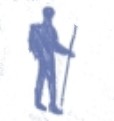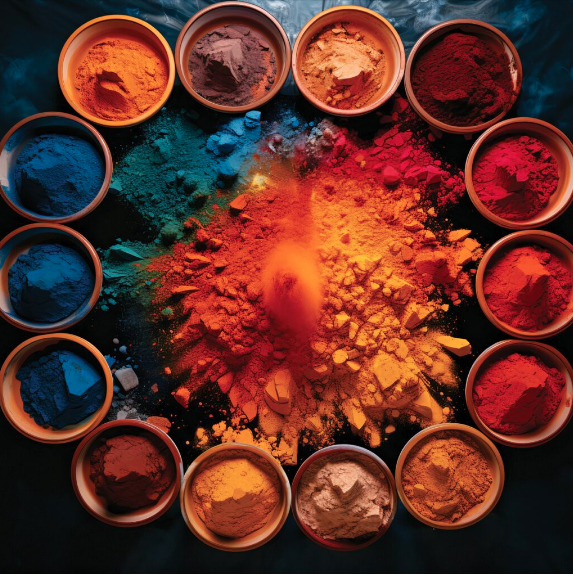Published in Perspective
October 2023
A random turning in the woods can sometimes lead to magic. I was by a West Country stream when something happened to my eyes: a patch of mud beneath my feet began to glow bright purple, as if my vision had abruptly flipped to infrared. Startled, I bent to touch the earth, and then looked at my fingers. They had turned to rust. What’s more, the ground was sparkling like a field of tiny stars. Against the vividness of the soil, and with the green ferns all around, it gave that clearing in the woods the intensity of a dream.
The name of this place, Golden Valley, had intrigued me for years, but this was the first time I’d stopped the car to walk there. When I got home I looked it up, and learned that the radiant mud was spoils from a former ochre works and the glittering dust was mica, the silicate mineral found in many types of rock. The ochre works is a ruin now, closed in 1970, but its colour stained my clothes for days. The next time I returned, it was with Caroline Ross.
Caroline is many things: a Tai Chi teacher, a bushcrafter and a craft practitioner who tans buckskin, weaves wicker bags and makes nettle-fibre twine. Once she forged her own sword, to be buried with her in her grave. But one of her main practices is sourcing wild pigments to make natural paints. Some people forage mushrooms; Caroline forages colour.
I’d always vaguely thought of colour as something intangible, abstract in a similar hazy way to an emotion. Our perception of it is: different eyes see different hues. But it is also physical, material and earthly. Ochre – deriving from an ancient Greek word meaning “yellow” – is a mixture of clay and iron oxide, which is another word for rust. It comes in different hues: golden (as the Greek suggests), red, orange, brown and purple, which is perhaps its rarest form. Caroline grinned from ear to ear; in all her years of grubbing up soil, she’d never seen purple ochre quite this intense before.
From her pack she took a trowel and filled a number of small bags, grazing the surface of the earth and never digging too deep. Some of the ochre was for her, to be milled and refined at home, while some was bound for wild colour connoisseurs around the world. Caroline is part of the Wild Pigment Project founded by American artist Tilke Elkins, which promotes socially and ecologically responsible foraging (another way of putting this is “take only what you need”). The project includes Ground Bright, a monthly pigment subscription service. Now mud from this South Gloucestershire woodland was heading for artists’ mixing trays from Australia to the American West.
Humans have always extracted colour, just as we have extracted food. Some of our oldest surviving art consists of ochre handprints and the flowing lines of animals in southern Africa, Europe and Southeast Asia. But pigment can be derived from sources that are vegetable (berries, leaves, bark and flowers), animal (blood, shells, urine and bone) as well as mineral (clay, rock and metal salts). Before industrialisation and the advent of synthetic dyes, people’s clothes were literally coloured from the place in which they lived. Think of Scottish tartan, dyed with blaeberry and lichen, or England’s Lincoln green, a blend of yellow weld and blue woad. For most of history colour was local; only the extremely rich could afford exotic hues made from materials imported from far away. Famously, Roman emperors reserved the right to wear purple made from the shells of Murex snails found in the Eastern Mediterranean, a symbol of royal status.
The early eighteenth century saw the first modern synthetic pigment, Prussian blue, an accidental reaction between potash, cochineal and blood. Three centuries later, turbocharged by the petrochemical industry, the world is full of dazzling colours that our ancestors never saw. Modernity democratised colour but it also dislocated it, severing its connection to a specific patch of ground. You might say colour has lost its place. Caroline and her fellow wild foragers are putting it back.
Thirty miles north of Golden Valley, across the River Severn in the Forest of Dean, is a place called Clearwell Caves, where ochre has been mined for over 4,500 years. Traditions run deep in this part of the world: since the thirteenth century, people born within the area known as the Hundred of St. Briavels have been able to claim the status of “freeminers”, giving them exclusive rights to dig for iron ore and coal. The mines are family owned and run, handed down through generations. The current freeminer at Clearwell Caves, Jonathan Wright, produces what Caroline describes as “the best variety of ochres in the country”.
On her first visit there, she found herself in an alchemist’s workshop: “Pestles and mortars the size of car tyres, as deep as christening fonts! Industrial baking trays of pure yellow, pure purple, pure red. But the colour changes from year to year: sometimes it’s golden yellow, sometimes it’s Colman’s Mustard. Some people talk about a pilgrimage to St. Peter’s Basilica, I talk about a pilgrimage to the heart of ochre!”
When Jonathan went to the Vatican, these pilgrimages were combined. He looked at the paintings on the ceiling, and – as he told it to Caroline – “the hairs on the back of his neck stood up. When he saw the red up there, he knew it was Clearwell red.” And so, amazingly, it was: records exist in Vatican archives of ships from Bristol bringing Rosso Inglese, English Red, which was almost certainly sourced from Clearwell Caves. The colour was distinctive enough to be recognised across the centuries: another example of Gloucestershire mud that had travelled far from home.
Alongside English Red, Clearwell produces a purple ochre known as Caput Mortuum, literally Dead Head. This was both an alchemical term signifying death and decay, and a pigment commonly used in religious paintings. The names of the Wild Pigment Project’s colours are no less magical – Bearded Iris, Belt of Venus, Glacial Bones, Caldera Tuff, In the Ruins, Ancestor Brown, Extinction Hematite, Deep Bank Red – each of them the distillation of a particular locale, the essence of a patch of ground. This work is alchemical too, but rooted in the everyday, in what is literally at our feet and under our fingernails.
Now purple ochre from Golden Valley has taken its place among these hues. Caroline has simply named it Spoils: the term for waste material left behind by an excavation. We have returned to that spot several times to fill our bags, taking only what we need, and for days afterwards its colour reddens clothes and skin. Trees grow over industrial ruins. Green ferns grow beside the stream. This was once part of the ancient King’s Wood that stretched from here to Bristol, a hunting ground for royalty. Its ochre might be fit for kings – but now, with our fingers in the mud, it is fitter for commoners.


